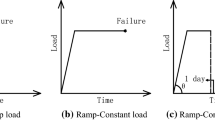Abstract
Lumber and wood-based products are versatile construction materials that are susceptible to weakening as a result of applied stresses. To assess the effects of load duration and rate, experiments have been carried out by applying preset load profiles to sample specimens. This paper studies these effects via a damage modeling approach, by considering three models in the literature: the Gerhards and Foschi accumulated damage models, and a degradation model based on the gamma process. A statistical framework is presented for fitting these models to failure time data generated by a combination of ramp and constant load settings, and it is shown how estimation uncertainty can be quantified. The models and methods are illustrated and compared via a novel analysis of a Hemlock lumber dataset. Practical usage of the fitted damage models is demonstrated with an application to long-term reliability prediction under stochastic future loadings.





Similar content being viewed by others
References
Agnew DC (1992) The time-domain behavior of power-law noises. Geophys Res Lett 19(4):333–336
Akaike H (1974) A new look at the statistical model identification. IEEE Trans Autom Control 19(6):716–723
American Wood Council (2018) National design specification (NDS) for wood construction. American National Standards Institute/American Wood Council (ANSI/AWC), Leesburg
ASTM Standard D4761 (2005) Standard test methods for mechanical properties of lumber and wood-base structural material. Technical Report https://doi.org/10.1520/D4761-05, ASTM International, West Conshohocken, PA
Bartlett F, Hong H, Zhou W (2003) Load factor calibration for the proposed 2005 edition of the national building code of Canada: Statistics of loads and load effects. Can J Civ Eng 30(2):429–439
Botev ZI, Grotowski JF, Kroese DP et al (2010) Kernel density estimation via diffusion. Ann Stat 38(5):2916–2957
Ellingwood B, Rosowsky D (1991) Duration of load effects in LRFD for wood construction. J Struct Eng 117(2):584–599
Foschi RO, Barrett JD (1982) Load-duration effects in western hemlock lumber. J Struct Division 108(7):1494–1510
Foschi RO, Folz B, Yao F (1989) Reliability-based design of wood structures, vol 34, Department of Civil Engineering, University of British Columbia
Foschi RO, Yao Z (1986) Another look at three duration of load models. IUFRO Wood Engineering Group Meeting, Florence, Italy
Gerhards C (1979) Time-related effects of loading on wood strength: a linear cumulative damage theory. Wood Sci 11(3):139–144
Gerhards C, Link C (1987) A cumulative damage model to predict load duration characteristics of lumber. Wood Fiber Sci 19(2):147–164
Gilbert BP, Zhang H, Bailleres H (2019) Reliability of laminated veneer lumber (LVL) beams manufactured from early to mid-rotation subtropical hardwood plantation logs. Struct Saf 78:88–99
Hoffmeyer P, Sørensen JD (2007) Duration of load revisited. Wood Sci Technol 41(8):687–711
Karacabeyli E, Barrett J (1993) Rate of loading effects on strength of lumber. Forest Prod J 43(5):28
Karacabeyli E, Lum C (1994) Failure rate and strength degradation in lumber under constant load. IUFRO S5.02 Timber Engineering Meeting, Sydney, Australia
Kass RE, Raftery AE (1995) Bayes factors. J Am Stat Assoc 90(430):773–795
Köhler J, Svensson S (2011) Probabilistic representation of duration of load effects in timber structures. Eng Struct 33(2):462–467
Li Y, Lam F (2016) Reliability analysis and duration-of-load strength adjustment factor of the rolling shear strength of cross laminated timber. J Wood Sci 62(6):492–502
Liska J (1950) Effect of rapid loading on the compressive and flexural strength of wood. United States Forest Products Laboratory, Report No. R1767
Madsen B, Johns K (1982) Duration of load effects in lumber. Part II: experimental data. Can J Civ Eng 9(3):515–525
Madsen HO, Krenk S, Lind NC (2006) Methods of structural safety. Courier Corporation
Schwarz G (1978) Estimating the dimension of a model. Ann Stat 6(2):461–464
Wang JB, Lam F, Foschi RO (2012) Duration-of-load and creep effects in strand-based wood composite: experimental research. Wood Sci Technol 46(1–3):361–373
Wang Z, Yang N (2019) Parameter-based applicability analysis of Gerhards cumulative damage model in residual strength and life prediction of wood in bending. Wood Sci Technol 53(6):1255–1277
Wong SW, Zidek JV (2018) Dimensional and statistical foundations for accumulated damage models. Wood Sci Technol 52(1):45–65
Wong SW, Zidek JV (2019) The duration of load effect in lumber as stochastic degradation. IEEE Trans Reliab 68(2):410–419
Wood L (1951) Relation of strength of wood to duration of load. US Forest Products Laboratory, Madison, Wisc., USA, Report No. R1916
Yang C-H, Zidek JV, Wong SW (2019) Bayesian analysis of accumulated damage models in lumber reliability. Technometrics 61(2):233–245
Acknowledgements
The work reported in this paper was partially supported by FPInnovations and a CRD grant from the Natural Sciences and Engineering Research Council of Canada. The author is greatly indebted to Conroy Lum and Erol Karacabeyli from FPInnovations for introducing the author to this important area of research, sharing extensive advice during the conduct of this study, and providing the Forintek dataset analyzed herein. The author also thanks James V Zidek for helpful discussions during the preparation of the manuscript.
Author information
Authors and Affiliations
Corresponding author
Ethics declarations
Conflict of Interest
On behalf of all authors, the corresponding author states that there is no conflict of interest.
Additional information
Publisher's Note
Springer Nature remains neutral with regard to jurisdictional claims in published maps and institutional affiliations.
Electronic supplementary material
Below is the link to the electronic supplementary material.
Rights and permissions
About this article
Cite this article
Wong, S.W.K. Calibrating wood products for load duration and rate: a statistical look at three damage models. Wood Sci Technol 54, 1511–1528 (2020). https://doi.org/10.1007/s00226-020-01227-9
Received:
Accepted:
Published:
Issue Date:
DOI: https://doi.org/10.1007/s00226-020-01227-9




